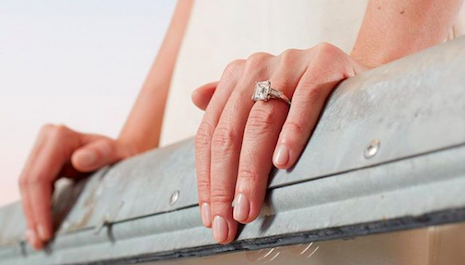As the diamond industry is expected to see a dip this year, compared to 2017’s 2 percent increase, jewelry brands need to focus on millennials and Gen Z to sustain their future.
Demand for diamonds increased to $82 billion in 2017, thanks to the United States and China. But this growth is not expected to continue into 2018, according to a new report from De Beers, which is urging the industry to focus on Gen Z, despite the age group's lack of funds.
“Those in the diamond industry must recognize that love may now be expressed in many ways, and diamonds may also be used differently to symbolise it, but the connection remains as strong as ever,” said Bruce Cleaver, CEO of SeBeers Group.
Diamonds and generations
According to De Beer’s Insight Report 2018, Gen Z and the millennial group are the largest generations to date. While millennials have significant spending power right now, Gen Z’s potential is just as important.
 Satta Matturi Endless Elegance long-rope necklace in 18ct Yellow/White Gold, rubellites, garnets, pearls and diamonds. Image credit: Satta Matturi Fine Jewellery
Satta Matturi Endless Elegance long-rope necklace in 18ct Yellow/White Gold, rubellites, garnets, pearls and diamonds. Image credit: Satta Matturi Fine Jewellery
Both of these groups share characteristics such as placing importance on the meaningfulness of love, digital native qualities, authenticity, individuality and self-expression, as well as being engaged in social issues.
However, millennials grew up in an economic boom and have sense of expectation, whereas Gen Z experienced the financial crisis early on and therefore value individuality and a competitive streak. Millennials in the West and Japan are now feeling pessimistic about surpassing their parent’s wealth.
It is imperative for the diamond industry to adapt to both groups' values.
Last year’s sales showed that self-purchasing in the United States is growing, now accounting for one-third of diamond pieces sold and more than 28 percent of value. Most diamonds sold are for special occasions, making up 63 percent of all purchases, and only one-third are intended for daily wear.
While the overall industry is expected to dip, continued growth is expected in the U.S.
Stable growth is also projected in China, due to economic strength and consumer confidence.
Rough imports is another trend on the rise, with India’s gross rough diamond imports increasing to 195 million carats in 2017.
 Producers of natural diamonds push back against the idea that synthetic diamonds are indistinguishable from the real thing. Image credit: DPA
Producers of natural diamonds push back against the idea that synthetic diamonds are indistinguishable from the real thing. Image credit: DPA
In the first half of 2018, sales of rough diamonds to cutting centers were higher compared to the first half of 2017.
Additional insight
De Beers’ introduction into the synthetic diamond market could shift the industry to become more widespread, but it will also likely impact it in unexpected ways.
De Beers will be offering a line of lab-grown diamonds starting in September under the name Lightbox, but its prices will be listed far below competitors'. The low price point will allow the line to become widespread but positions synthetic diamonds as far below natural diamonds (see story).
Despite the rise of diamond disruptors such as synthetic stones and gemstones, the majority of consumers from the United States and China plan to purchase diamond jewelry in the coming year.
A report from diamond miner Alrosa and conducted by GfK found that 86 percent of Chinese consumers and 59 percent of Americans who have bought diamonds in the past expect to buy diamond pieces in 2018. While some are turning away from diamonds due to sustainability or social concerns, this study indicates that there is still strong interest for repeat purchases (see story).
“While the diamond sector must continue to meet the needs of Gen X and Baby Boomers, there are considerable opportunities presented to the diamond industry by the rise of Millennials and Gen Z, provided it commits to understanding these generations and adapts its marketing approaches to incorporate the needs and priorities of young people,” Mr. Cleaver said.
{"ct":"QGPI0JFY7uZgIf+KsRzaLANntCU7TSJvTc\/bxXNJSDIGmIK2yd+f\/9\/syxuHtTOVeIklsbMF\/MaldkQJbWEajCUjDUdAk6jG3FRqq+QE1ePIzmKt6BS36Gg\/y8098z3fHgr7dCYxnZ1RjzucH707eZaaESdghyhK6VKXkFb+\/O8Kf14q8Jxv3VWCtX3SCSYt5ocGZ32XMvWtPrPPA9idrq80k6D5jG\/xthvVftqEOZw\/i4fD5bGpPKmniNpJ0SImD4FYIHzixJ\/Xjv1\/3SQsKWwDjsmJei\/\/tBdpHvxDHKpmOUs7JZE6WuijHd35dqflmYzqK3u7H3HSs09LJ\/gMPszWkMuvvANeQBJE+1MKmGt0dYUlM5r6B7sIJvXsRMOMtusb8OErp0TdQ19e7K3i1WsHqdzcrQE0kAwJE\/a6Nc09iZbzHAfyUdp9vEDbNQF7YyJDYf5yGS0LfYOGzqpkFOv5V358h7TA36OPQUYB1EfcazqaqDf3rjy4bI3UsCdKEn6JHWLfksCzTSW+e+T6ZkZJv+P5Iz6bMfqEr1Ougmf3SPEFjMYO1TeS0tzUAnXPnn6If1ufRr0aIlkx\/2S9mcyg1QpBDQy\/+0IAY1+m8u9RXu03gWJraypRT8GqmQYrEwWUF8WR4U+gtEl+dPKwVIIzvO\/RYZ+fE2p93n02PbzKfCeAWquzQvNdMMqEB5TsLjs6KQPToif\/RWD4ZaoMWgMTFCm+j\/aRRHola7CRe8O7Vhxeh0psU+9J1PCNTgc9ZjY1Jl+gh+09OcfRPftZjTNi0\/i1vjHReOi\/dTy\/TqgaElxJnV\/4Jz6MMtY9vVGtu2wQZG\/XXViBkSXXCzsvxZmMfGlI3ogGe5YM3Iqsterd7Jy9nbKsguTw+cM0KtE79hVhbi8NmeembcLGM9s6uNN6xDUXM1PgmusT+GOLin93+icbvLIQiekEQzfADLH\/rIsFw5ZoZ7cWItWpXq5cqIQUAq8ZqV1AU1W3chV8CzLUcEeKdwlXFtCFsZ8BeWYsfVYnUimGsrv3dDQ+mrLOSE+haA8i\/zBZW\/FxwqgnmbR2WbK8NYBScMNw4pjPwNTRfOTu+FlJWuriA2KrpeH6RDyEEtNnxCRPm2wLMY3bhuDdFyjv2xrux7Q+PP1LStiavIUI4TW+CEibHmqPCcW\/h6h883tb9Wr5dv00c+ddZijmQ9gt7dRVhFHlyCHiwwCEqzfOm\/AM+qR8IXqhCLc2\/KleHZWg4a2hpumrYpzOO5qggN2MybE7zOx7XbA4IBM5QmuPWdOob6yYKo3AMU8cVyf3TY+1Q1cCiEjkcqyykOiKDUFSrqBnM1BIs+8M8eIbyXH\/sl4h1m67ZPSHAGzoZgFzDvjciAtnJjI2cmdCrCIUSGPhOCs0IlfRYBtzKnAFxzPmrkvLy2WTwrqVaXpri6vYpkmma4IiRuLHyXTAPRgFAYwmJDArJzeBks849ilYBRtfAovx7aisAWil6FflnZ66AcT0uwJmqPy9XCp2svKFb8Ki2sfwocDyaqhGGCFaF1qDIx+IlQNMl0rkk9P4xSB\/Z3IuHOSvqtGXybFRYQEq8JO7snU2xnzmQdGCZkh0yc4AEoYmyzZatHI10EOyKuPiaDMT+t4uuRzhENIvfhGo9CQ0GTiES9LzlS2iDI45w\/H\/1MENNwqN28E\/rVI8+g8nZr8vIoGssjpJKoOJp\/2rzPRFjyTLeykWFyETPaLvnc4viWvz5CK8tJ1xYIuuKeOJnJlPvA9yRYNNiAgygvokg3\/RfMGbPaMb4D0h3lmgBhtvkzEtEdag8YzJqevxkOOFLUOgu7+w0Wp3\/14ZXHptZjVJMBjLpVosYANz\/Iap59HX8j7CQW6SMi1J63Xe5MAWJLl\/e+6w4TRObKNe8pNPT6im2obilc6kduyniJQRyFuua3jME3uYlryprGAZi4K7kb5YItdecmR0v2Ymq1XaIuwV3OWrtpfEPhO9wMzNHTttJtH9Ji5B7pPTp4ZIJHlXzVSep77bvliLPnm7R7nwCBG6NACQUTSzF97ofg5rRZcaMbDrSI733DbtND4Jlv2QqG0xAenq0nqxfPtH6QU7fb4W7BvG\/rn62a+q9moHl6SW88L7KHOZxlAJQweXpugZQwhwIdBihZ+LyUcU5VeG8iuaegKt2OjdPAuo+9YtAMdlMCLB2pZMdUrddblvmu7X\/y3NXynYvPfl8vvIkggWh9PovlbOWcZ87iXNWCa3f9hPyTES22r9E39kYi9+Gx6E\/yd3ndJM0XeyyoAJOZx6Ew+MCPuNqESQGEQdsk5iCKEr9ib9a+W5RKRwwDVaQe\/\/64kFCgiz3+PEPGjY4oHWBpWAYo36TmwwxQE2XbalR6jDs0M5jF4sktiKNvb3pAm6LJkI2J9FKPGJMBHVUOu2FgXLW0mqapQB9IqtzLH\/4FOOMVF\/c4RNZrjOg1AX8EeCcTa5OeEIkk6h10uxGuMIZvyO\/dYtvInBte6USkq0v\/MX8Az+hhfrzq\/fpP2d0ZqJuBS84CszJdIotfNiLtZHCD8L3l1tvarXHAMiAtccn\/hnL5CNOggyPdFJ1u0uf2a34Bd\/Z4rBmXLxKShTC++DlvZzqm0ROZomqWDTQghFHrvMKb6huAyBhnyMHVr5o9ZIeU3vnFqnu3+6txzbtY8q\/kY8AT5gwf6uYwwrjg5A8+K7t\/7aOw\/Kq2+keNAV6J7SysJ4zoQk7eMFlTHk2wCHOs4AGJF0p6QyNj7nuOg1eBC23X4a+wkCSLsHH32cW34bz2ga3FV+76jOKrvnuuPK2qdgSD7DcxSvQKL5dFlSf3smBXgbTa\/CxuqR32gmYbbp9pM47XfzGkEh01jQZBY4KYagGL2JXw9NjpyDpoei\/FFDKCl4SVz\/C7GcN8NxxmIuuo5BeoBq4VqBMDL6Ecu3m8yHLPN55jU2I6AlHkIXXyS7laG391hSJX2rSXR4dUrtmJqXl1\/PhMH08H89QMbdHrGG\/+okryo9gY0wNtIMdh8tQWq\/s3OvZQ4nuSg5w5n6t0ScRHk96eabRDcp1OqN+ntLdn3v5u5xsEI+vY6Sg\/JoLrdpqheB\/QxKgH\/QqADBZcBmSalvvUF2\/WRnd2FnyBQTAwGiuvawiQNtFkNMdpvZyfM1Jhw74+rGsUu3vaYKIAnHwVynEXjL0Vvriyh9KLm+tJ6+ifwinTxikArr4kXT6TARg3NJnCecU\/aUu+a8sRfDexkG9x8h0XrTd2qJe4bSSndLTvgq3veYHTriL59KWeznWcV1K\/sGHtA0y9AFbKk+3Dyqq0EeMBG710bmpearoGvhNaOBQKfeJAHllIq2dfmWf3Yp4CudepO6jKVG2T+21lzpNQzgTkLnn0nDB0Tyzpnr+qW0WmTg5Bx1ndMzADf4d7vEhqz7lTEsBjFsYrsxOrnkXxJM5fUxTKmKTf45gtaJpmc3yI3cHGKhodKJ2qUr23dPfY7o9wan7TgcyAAhzld2FntLbG171m4aBRdLicETuKj2fRsaHVMQP0+Y4Ky\/fZEY4\/Lbm52Ezy26OLsDd\/r2WnyJ0BrSsifoaetBV9L8yIhtiatmZBE47D7yYeeqnDYorrAoUFD0ltbH69sAAZPC9aIyhRHuB4vHr1W6kZPHkOE7M4ky7qf2f8ykaXIarQiMq8BJe8rOiSWqqLEOITnfhw1BoiXpFkgrcfegOCB3JW8hlFaRm4Eg4vF9m9CCacNIPH5nG7AwtgwthZw4DTYFffuFxYyRT5Emn5JNgUXJy\/PEZ60RrgkPMSp58RhJZVozMeVpcqPkK\/iuQ4GRg1YY8+PpF4vV8y1z3\/7lQAWdJhMytHZRzlVNsE+qF07g\/jVjE5Slgs1tCwgpXIgcTo+Sl2fIfaHOn419OA6o7IdsxI0ekaElS2JlAiKajOCradbzL5QRSb2e4o\/FwLQYdIFRkeA47yJrziXib\/ZAGP7TG7THviypIitcUMpfcgYxiqLCTyHKNXGGJD81bWqe7I6Kh4NClura\/EjVa+eW8BI7OmcTqqHtqRfRMpo6JOmbMDZr3STd+asWQBDGUtwMAKVYIE0oh7htdG2WwhRcsJe39EhvpSn7LLmD2JG2Y6AzoDa9dLZPTCFeYf04TCyW7\/OxIkYWrtN7dgf0NX0ix8LzlTgyDbSsmCvTn+z5PgmVXvlsdP2+lyLYK7EZcy9oyrxsRCJUJ0y2vxS74mMYXP+RGqJLBB+rTOA43aCeJkhoZqlAU3nftB\/2t+7mVs\/8A8sVFwQAwJ1Awv\/h22Mtsjznt24gbJkPZExhHA9obZ7tKrzhK+zRmU8VzSLFfsOJdS\/YjeUWDTseawnVt6PQlclfumv70uEs877ESX6IYT0wYE7tLc3xnH683WJQxrVl42CLDFLe\/yQnmzV65noJ6K8NM2ESgiD7wrNzSxlezcye3EdHtT\/j6Ro5n61Ba+UuEJa658OksMyjJA9qdIzYbeKbXodxCaeMLgbwuWWtDL1Cqw5qrdlZRRGJpASmeaXCpIgX+xiY3tTbyDINkYHcJyL5m\/gzOmI+HhF5aGjQ5VOeWJ8+1fwxXb6r+wSNfDVqjuYnIHtolRlyoX+N7dc64uUaDfyYtO4qLOoG+0u9fSFlRVy04UeL+U5DX6ZvUm0lZkd4XzX1E71LKES9EfoHgXZDfSTP7idvWsBzouxiZwPmYYV3tLqBjnCpExGqFS7eOdbP4VpsHwRdim+dgM1+a9BAxlnQa0spOOBmC9lPygjnVGx2AXre6FGv+2EuPleE+aBPLTU5gV0aATDS8EdiYCUMv85ZsSRTMv6hFcJ0v9O4V\/+K9d77k1ld5OOXTpsfS6\/sPWHfiZj82dOn1ogNrybjnf8FUuGdhNQ265mZ4ibs3O43Qn5uCKgjSfkb8PhqbyJ+5X2TQJamCLMudcCkEg3cOlzSbs6SwkLaJL\/cxdnwyt+DfPvkinsigeuf1BHp01z42EjjZDxIjKSY7DCsVf6TKi0iru4\/Vy3uFp3CPB0zzAd+rDk7\/xxW8yc2Z9EeDWZKW6S9ca9WQIuhF0sKGlS046UxU9rD2oxcI+3cIEnV7mGC\/zCs+ts059AnCoPNCH8lW8h2sIGT+dFrB8vgPqOsLOFTosVKdf9UHNBP8NSgBcDMgMc3d+K4qSk4pycMIUzzly\/tQYdxbe6yWwRxRvdS8wsw0tKoZazc0iUVXiUXHCn15JLGHgjieT7SZBaIUf70v7n+z8LfQH4Xr9EhU9FcRPx1+4328pcVscHeHMx+UZtKHn+GuXCWz79Uj61gSO0yRvm1dKYGPE3id5ievKlS3XZ2JKkjpLzjL8uXAxdIcazWVMCl47ioboxdw1K0ga5YOi\/Az6OAsJ5adLO4uYCKkpHCjzFdjhzrpWoPnKrNea36DuhbpX+7u3A9Yt5T9ZHrKVSrr\/8iSSdWl1OX8R2no7Wu3PZxRDPznJMoWX2zjhOmFVFMqhYdM9ZKFV7tbo59jik2CWUYVk0O2soyyy76Y1ITo7aZdlbDqO5TMaXg67P8o1y32W3yO\/aj4DdemiTF3b9cwbjnOqXoWH+dpOU\/BGoj9n46X\/dgbHfUZf16fpIYKq5lZ+nwirvUT5HxnE7MHnRU2JRVUxey7U\/sL\/7gBz31Dz1x1sOQCROp7ZungZb2U5bq1hPpf+KTAeF4wnHyZJMqCnq4wQHFJqx\/9DIcNYN7juDzME9vfHj4naJ+70LTvk2oQNdk8MWNjmzWs8JzG\/7lB8FJXsoboBrBZTQM6U1r97kd6lopJqE6vrUyJhHuI1NzqJ6vlW+mGKh+MU+BDI9CI0zbNP2ypBB+\/l7gLbe2GhCpiXWLo69BS9\/SUC8t4z90MIHQbpHf58yAPqjCkTe2MdBq5vrM41tSJCHfK4XWD7YBnGkTdOxPHGpGycJpe5kjNhbUfsXwyrCklBT1GMdRRy+PfIpQkbyI4Iw3wqx94ZFAvv+iHy8RE3npKTYum3WV6i6hrAnWv4Fg2TiY\/R5HTidTDe99iFgIEiG3MzDOrEeth+4vDmGnVLT7Guj\/cI\/gjPcWp4AVKqNd4\/+ScHfb+5wb5oz0SR2EIOnSGLQFRhx5cZX1rE0\/0DjWQZ0pSV\/hS2LeQzAFRIj3buTAAICZr7l0QLZ+dj0FHL+Pl3p19Hwprc14KOsPl+GqjsYLgH7pK38on\/+LQboRG4bYuE7vOHpevBe4D\/A0++8NqDLbc5flu1ddgAAC20cSUpmRHqhWBiIdBP80HezDp6xt12SIdbxuqEqTwjM6ynzuuNS3q+Y1x0RXXDgTQ8ydTCs1JHh\/PrX9xPa22k4aNo4O7YYTWLpw7yndgeUTx+0l0NS+wtYYFw\/Pmj9lBV6g+y0nN1hiWusIxIFaNSa6ElAUnUHonZ93hjaMDNJLlX0Kcn03ZoxBgQafyTzJoCez5zsEvBooBL0uPz\/CeLQvtW+Y21dFIS4iXfxcbkEX5AVXx\/AVULCXBK4evH\/jRgSHaCY29NV2Ez\/dywlriR1sCe8W+WLCUfwC\/qGjjyJs18NnXHxC6uAHPhworJkJDVAEndwLmKKBIHKLCiImQEdu0sMBhzcwbzDFOQIIND9MvZsEH9F1iBFUcI1khkv4uujTmalFIXKeabqoFoEVZlN8NwHazYsDfwlTsX2j8HKZ9siJlT5LhMqTs8+ncLPigckfhWJ5ZFV3XaYtf4Ty9jsDKwbkJwjEHoyCzQ7ll3TrUpFtf5gXZi9\/W7r9XmtSSb9ZmbOVEJFURO4ttoVrxECNudGfTTka3NTEMw\/tUY5etbTj89X1L53cGhPFa7\/vpWlAeswwnGAcGIayGAfWGnTy1bLQ77cTpC\/RoaI01GfYrU4fg+KcZ76bllta+1yAl\/94RvItja2FAHV8NeD2S6yfR93\/9CVAc44THcpUebhXt1e4YzE+EtuzMYIHwkPjLEgSVUpIQ+uYH\/odJRdkq0ip1VOMmhvmkU3CB4xBgcwu9wZlufXcGbm34DHK9+bXhP3DGXpI0FEL97DgXYiCqxeo4QQop0f92sEDZqBAQ4Nmnf+E3zbGRBy8o6vzZo7UHhrRvk4bUGk+FL8zUSjjngnvAO\/8VdIHFVw50oyM6hNPC6Ky2N1BDwuY13beLvUkPsr\/o9k78mJoToz6fHl6riWkxeW7x4vl661QO6BpvlyrAqy8+wmDxfuiSu+wzlRblj++v8hFAMa20gY53+7fH2gXsfwZXNlhoOKUzpB79ftg2OG9\/5Xw65WX3QFCgw6M461nIybctLnGn1qUy1nyQE0c2JehnXztEF3nn3FVgcNQKfZ\/NThCeSj\/rztFs5xXfapLGVf0YJUgOnjaDK5Em7CISLGJViFlm4MLrgNQAFIRqgv1Xnq3GX2GAXtGgH4gmhtNrEtGxPNFWg8zZa6JV5D+Vm1Xcf5X9ekL1hB42hF0NxiuZHfBvK12m48yWLvc5wEjS9ilzU6tUKWluQ==","iv":"a81ff792b506a2bcfe69fb9d7b4e2cd7","s":"9f433090b8fc8ab9"}

 De Beers caters to millennials and Gen Z. Image credit: De Beers
De Beers caters to millennials and Gen Z. Image credit: De Beers
 Satta Matturi Endless Elegance long-rope necklace in 18ct Yellow/White Gold, rubellites, garnets, pearls and diamonds. Image credit: Satta Matturi Fine Jewellery
Satta Matturi Endless Elegance long-rope necklace in 18ct Yellow/White Gold, rubellites, garnets, pearls and diamonds. Image credit: Satta Matturi Fine Jewellery Producers of natural diamonds push back against the idea that synthetic diamonds are indistinguishable from the real thing. Image credit: DPA
Producers of natural diamonds push back against the idea that synthetic diamonds are indistinguishable from the real thing. Image credit: DPA